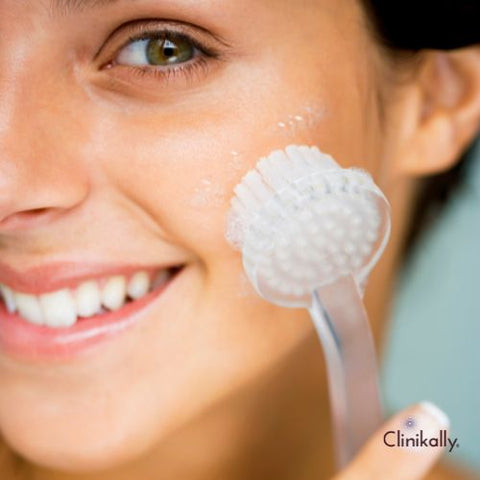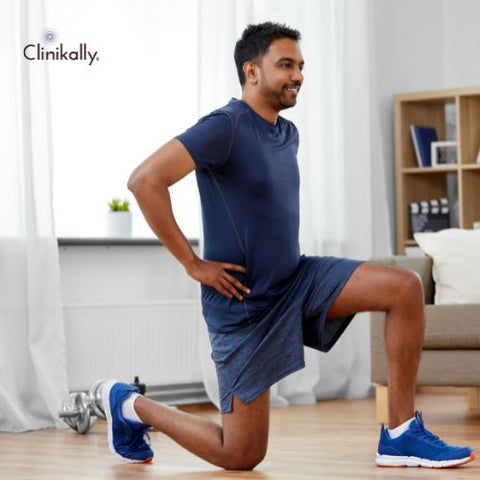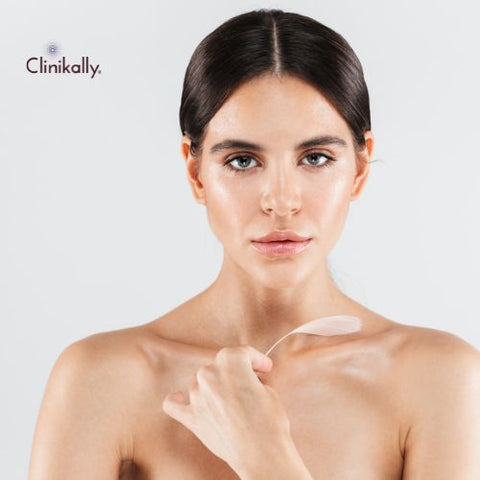Exercise has numerous health benefits, including weight loss, improved cardiovascular health, and improved mood. Many people, however, are surprised to learn that exercise can also improve the appearance of their skin. Exercise is a great way to maintain healthy, beautiful skin. Incorporating regular physical activity into your routine will nourish your skin from the inside out and give you a more radiant, youthful appearance.
How Exercise Benefits Your Skin

Exercise has a number of skin benefits, including:
-
Increased blood flow: Exercise raises your heart rate and enhances your blood flow. This promotes healthy cell turnover and overall skin health by supplying your skin cells with oxygen and vital nutrients.
-
Reduced stress: Exercise is a natural stress reliever and can aid in lowering cortisol levels, which, when high, can cause inflammation and other skin problems.
-
Improved sleep: Research has shown that exercise can lead to better sleep, which is crucial for having healthy skin. Your body is better able to repair and regenerate skin cells while you sleep, giving you a more luminous and youthful appearance.
-
Detoxification: Sweating while exercising aids in the removal of toxins from the body, which can result in clearer skin and a decrease in acne and other blemishes.
-
Increased collagen production: Exercise has been shown to increase collagen production, which can help improve skin elasticity and firmness.
-
Reduced inflammation: Regular exercise can aid in reducing the body's chronic inflammation, which can cause a number of skin problems, including rosacea, acne, and early ageing.
Boosts Blood Circulation for a Healthy Glow
Exercise promotes a healthy glow in your skin by increasing blood circulation. Exercise raises your heart rate and dilates your blood vessels, allowing more blood to flow to your skin. This increased blood flow brings oxygen and nutrients to your skin cells, nourishing them and encouraging healthy skin cell turnover. Exercise can also help stimulate the lymphatic system, which is responsible for removing waste and toxins from the body. Lymphatic fluid is pushed through your system as you move your body during exercise, helping to flush out toxins and other impurities that can contribute to dull, lacklustre skin.
Acne, eczema, and psoriasis are just a few of the skin conditions that can be prevented with regular exercise. Exercise can help to minimise the appearance of blemishes and promote a clearer, more radiant complexion by reducing inflammation and improving overall skin health. Finally, exercise can help reduce stress, which can benefit your skin. When you are under stress, your body produces cortisol, a hormone that can cause inflammation and other skin problems. You can help to minimise the negative impact of cortisol on your skin and promote a healthier, more youthful appearance by reducing stress levels through exercise.
Reduces Stress to Prevent Breakouts
Stress is a common cause of breakouts, and exercise can help to reduce stress and prevent acne and other blemishes. When you are under stress, your body produces cortisol, a hormone that can cause inflammation and other skin problems. Cortisol levels that are too high can also stimulate oil production in the skin, resulting in clogged pores and breakouts.
It has been demonstrated that exercise reduces cortisol levels in the body and relieves stress naturally. Regular physical activity can help to reduce stress and anxiety while also improving your mental health and well-being. Furthermore, exercise can help promote healthy skin by increasing blood flow and decreasing inflammation. Your blood vessels expand as a result of exercise, allowing more oxygen and nutrients to reach your skin cells. This increased blood flow can aid in the promotion of healthy cell turnover and the prevention of breakouts. Exercise also stimulates the lymphatic system, which is in charge of eliminating waste and toxins from the body. Lymphatic fluid is pushed through your system as you move your body during exercise, helping to flush out toxins and other impurities that can contribute to acne and other skin issues.
Promotes Collagen Production for Youthful Skin
Collagen is a protein that is essential for the strength and elasticity of your skin. Your body produces less collagen as you age, which can result in wrinkles, fine lines, and sagging skin. Exercise can help stimulate collagen production, which can keep your skin looking young and vibrant. When you exercise, your body produces growth factors, which stimulate collagen and other important proteins in your skin. This increased collagen production can aid in skin elasticity and reduce the appearance of wrinkles and fine lines. Exercise is a great way to boost collagen production and keep your skin looking young and vibrant. Regular physical activity can help to keep your skin looking its best while also improving your overall health and well-being.
Post-Workout Skincare Tips

It's critical to take care of your skin after a workout to avoid breakouts and promote healthy, glowing skin. Here are some post-workout skincare recommendations:
-
Cleanse: After working out, you should cleanse your skin because sweating can leave bacteria, oil, and dirt on your body. To get sweat and impurities off your skin, use a mild cleanser.
-
Hydrate: Keeping your skin hydrated requires drinking a lot of water before, during, and after exercise. After your workout, make sure to drink plenty of water to replenish fluids lost during sweating.
-
Moisturise: Exercise can deplete your skin with moisture, so it's important to moisturise after your workout. Choose a lightweight moisturiser that won't clog your pores.
-
Protect: If you plan to spend time outside after your workout, make sure to apply sunscreen to protect your skin from harmful UV rays. Even if you don't plan to spend time outside, it's still important to apply sunscreen to protect your skin from damage.
-
Avoid Touching Your Face: To prevent transferring bacteria and oils from your hands to your skin, avoid touching your face both during and after your workout.
-
Don't Wear Makeup: Using makeup while exercising can clog your pores and cause acne. If you must wear makeup, pick a non-comedogenic formula that is lightweight and won't clog your pores.
-
Shower: After working out, taking a shower can help to remove bacteria and sweat from your skin. Use a mild body wash, and stay away from hot water because it can dry out your skin.
Cleanse Your Skin After Exercising
Yes, cleansing your skin after exercise is necessary to remove any sweat, dirt, or oil that may have accumulated on your skin during your workout. Sweating triggers the body to produce sebum, which when combined with dirt and bacteria on the skin can cause breakouts and clogged pores. After exercising, cleansing your skin can help remove these impurities and prevent breakouts. It is critical to use a gentle cleanser that will not strip your skin's natural oils. Look for a cleanser that has been designed specifically for your skin type and contains ingredients that help to purify and balance the skin. If you're pressed for time, a cleansing wipe will quickly remove sweat and dirt from your skin. When you have more time, you should still follow up with a gentle cleanser.
Stay Hydrated to Maintain Skin's Moisture
Maintaining healthy skin requires staying hydrated, especially after exercise. When you exercise, you sweat out fluids, which can cause dehydration if you don't replenish your body with water. Dehydration can cause your skin to become dry, flaky, and tight, highlighting fine lines and wrinkles. Staying hydrated can help keep your skin moisturised and prevent these signs of ageing.
The best way to stay hydrated is to drink plenty of water. Drink at least eight glasses of water per day, and up your intake, if you're exercising or spending time outside in hot weather. You can also hydrate your body and skin by eating foods high in water content, such as watermelon, cucumbers, and celery.
Apply Sunscreen When Exercising Outdoors
Yes, you should wear sunscreen when exercising outside to protect your skin from harmful UV rays. UV rays from the sun can cause skin cell damage, resulting in premature ageing, dark spots, and an increased risk of skin cancer. It is recommended that you use broad-spectrum sunscreen with an SPF of at least 30, which will protect your skin from both UVA and UVB rays when exercising outside. Apply sunscreen 15-30 minutes before going outside and reapply every two hours, or more frequently if you sweat a lot. It's also important to choose a sunscreen that is water-resistant, especially if you're swimming or sweating during your workout. Water-resistant sunscreens can provide protection for up to 80 minutes in the water, but it's still important to reapply as soon as you get out of the water or finish your workout.
Exercise Routines for Different Skin Types

While exercise is beneficial for all skin types, certain workout routines can be especially beneficial for certain skin types. Here are some workout routines that can help improve various skin types:
-
Oily Skin: High-Intensity Interval Training (HIIT) HIIT workouts can be particularly beneficial for oily skin. These workouts involve short bursts of intense activity followed by periods of rest. They help to increase blood flow and oxygenation, which can help to reduce excess oil production and prevent breakouts.
-
Dry Skin: Yoga is a fantastic exercise program for dry skin because it enhances blood circulation and encourages relaxation. This can nourish the skin and enhance its tone and texture. Additionally, yoga's slow, gentle movements can aid in lowering stress levels, which can accelerate aging and cause dryness.
-
Combination Skin: Cardio and Strength Training Combination skin can benefit from a combination of cardio and strength training. Cardio exercises such as running, cycling, and swimming help to increase blood flow and oxygenation, while strength training helps to build muscle and improve skin elasticity.
-
Sensitive Skin: Pilates Pilates is a low-impact workout that can be particularly beneficial for sensitive skin. It involves controlled movements that help to improve posture, flexibility, and muscle tone without putting excessive strain on the skin. Additionally, Pilates can help to reduce stress, which can trigger sensitive skin reactions.
Best Workouts for Dry Skin
Choose workout routines that promote blood flow and hydration to help nourish your skin if you have dry skin. Here are some of the best workouts for dry skin:
-
Swimming is a low-impact workout that can help improve circulation and hydration, which is especially beneficial for people who have dry skin. The pool water can help to hydrate your skin, and swimming movements can help to increase blood flow and oxygenation.
-
Yoga is a gentle form of exercise that can improve circulation and promote relaxation, both of which can benefit dry skin. Yoga's slow and controlled movements promote relaxation while increasing blood flow and oxygenation, which can help to reduce stress and prevent dryness.
-
Barre workouts are a combination of ballet-inspired movements and Pilates that can improve circulation and hydration. These workouts include a lot of small, controlled movements that help to improve blood flow and oxygenation while also encouraging relaxation and stress reduction.
-
Dancing is a fun and energetic workout that can improve circulation and hydration, both of which are beneficial for dry skin. Dancing movements help to increase blood flow and oxygenation while also promoting relaxation and stress reduction.
Effective Exercises for Oily Skin
If you have oily skin, it's important to choose exercise routines that help reduce excess oil production and prevent breakouts. Some of the best exercises for oily skin are High-Intensity Interval Training (HIIT), Cardiovascular Exercise (such as running, cycling, and swimming), Strength Training, and Yoga. Exercise that increases blood flow and oxygenation while decreasing stress can be beneficial for oily skin. It is critical to select a workout routine that you enjoy and that is appropriate for your fitness level and skin type. Additionally, after your workout, wash your face to help prevent breakouts and remove excess oil from your skin.
Recommended Routines for Sensitive Skin
If you have sensitive skin, it is critical to select workout routines that are gentle and will not irritate your skin. Some of the best workout routines for sensitive skin are as follows:
-
Walking: Walking is a low-impact exercise that can help improve circulation while putting a little strain on your skin. It's a gentle way to increase your heart rate and get some exercise without irritating or aggravating sensitive skin.
-
Pilates: Pilates is a low-impact workout that focuses on strengthening the core and increasing flexibility. It entails controlled movements that can help improve circulation without putting undue stress or strain on your skin.
-
Cycling: Cycling is a low-impact exercise that can help improve circulation and raise your heart rate without putting undue strain on your skin. It's an excellent choice for people who have sensitive skin and want to get some cardiovascular exercise.
-
Yoga: Yoga is a gentle form of exercise that emphasises flexibility, balance, and strength. It can improve circulation and reduce stress, both of which are beneficial to sensitive skin. It is, however, critical to avoid any poses or movements that may irritate your skin.
Debunking Exercise-Related Skin Myths

For years, there have been several exercise-related skin myths circulating. Here are some of the most common myths and their debunking:
-
Myth: Working out causes acne. Truth: Exercise does not cause acne; however, sweating can lead to clogged pores and breakouts. In fact, exercise can help to increase circulation and lower stress, both of which are good for the skin.
-
Myth: You should stay indoors if you plan to exercise outside because the sun will harm your skin. Truth: While it's true that the sun's UV rays can age skin prematurely and increase the risk of skin cancer, exercising outdoors is still safe as long as you wear sunscreen and protective clothing. In fact, exercising outside can be advantageous because it gives you access to sunlight and fresh air, which can enhance your mood and general health.
-
Myth: Makeup should not be worn while working out. Truth: Although it is true that wearing makeup can lead to clogged pores and breakouts, it is not necessary to completely forgo wearing makeup when working out. However, it's crucial to pick makeup that is non-comedogenic (i.e., won't clog pores) and to thoroughly wash your face after working out to get rid of any sweat and bacteria that may have accumulated on your skin.
-
Myth: After working out, you should never wait to take a shower. Truth: Although it's important to wash away sweat and bacteria from your skin after working out, it's not always necessary to take a shower right away. If you can't take a shower right away, you can use a towel or cleansing wipe to wipe away sweat and bacteria from your skin until you can.
-
Myth: The only way to get healthy skin is to exercise. Truth: While exercising can help your skin, it's not the only way to get glowing skin. Maintaining healthy skin also requires a good skin care regimen, a healthy diet, and enough sleep.
Sweat and Acne: What's the Connection?
Sweat and acne are linked because sweat can cause clogged pores, which can result in breakouts. Sweating causes moisture and oils on our skin to mix and accumulate in our pores, along with bacteria and dead skin cells. This can cause the pores to become clogged and inflamed, resulting in acne formation. It is important to note, however, that sweating does not always result in acne. Sweating, in fact, can be good for your skin because it helps to regulate body temperature, improve circulation, and flush out toxins. Exercise can also help reduce stress, which is another factor that can contribute to acne.
Keep your skin clean and avoid wearing tight, restrictive clothing that can trap sweat and bacteria against your skin to help prevent sweat-related breakouts. Here are some suggestions for avoiding sweat-related acne:
-
Wash your face after working out: After working out, cleanse your skin with a mild cleanser to remove oil, bacteria, and sweat.
-
Wear breathable clothing: Choose loose-fitting, breathable clothing that allows sweat to evaporate from your skin.
-
Avoid touching your face: Touching your face can spread oil and bacteria from your hands to your skin, increasing the likelihood of breakouts.
-
Use non-comedogenic skincare products: Look for skincare items with the term "non-comedogenic" on the label, which indicates that they won't clog pores.
-
Stay hydrated: Drinking plenty of water can help to flush toxins out of your body and keep your skin hydrated, which can help to prevent breakouts.
Can Exercise Cause Premature Ageing?
Regular exercise is generally thought to be good for overall health and can help to slow the ageing process. However, there are some exercise-related factors that may contribute to premature ageing. One thing to think about when exercising outdoors is UV radiation exposure from the sun. Prolonged exposure to the sun without protection can cause skin damage such as fine lines, wrinkles, and age spots. When exercising outside, it is critical to wear protective clothing and apply sunscreen to avoid this. Over-exercising is another factor to consider, as it can cause chronic inflammation and oxidative stress in the body. These conditions can hasten the onset of age-related diseases and hasten the ageing process. To avoid this, practice moderation in your exercise routine and avoid pushing yourself too hard.
Conclusion: Prioritise Exercise for Radiant Skin

Exercise can be an extremely effective tool for achieving and maintaining radiant, healthy skin. Regular exercise can enhance collagen production, lower stress levels, increase blood circulation, and help the body remove toxins, all of which support a healthy, youthful complexion. However, it's important to remember that exercise isn't a magic cure-all for flawless skin. Still, you need to take good care of your skin by following a regular skincare regimen, shielding it from damaging UV rays, and drinking plenty of water. You can achieve and maintain radiant, healthy skin that glows from the inside out by combining regular exercise with a healthy skincare routine and other good habits. So, make exercise a daily priority and watch your skin and overall health thrive!









































